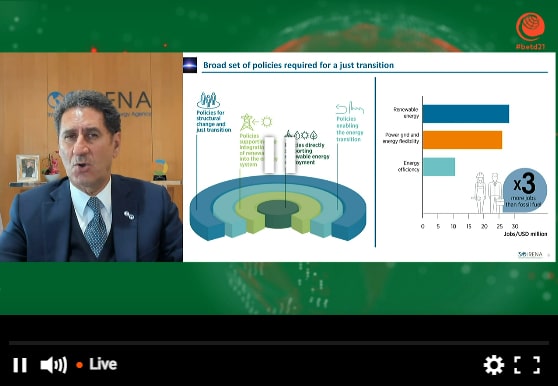The world needs to have hit 14 TW of solar generation capacity by 2050 if the global temperature rise is to be capped at 1.5 degrees Celsius this century.
While the estimate made by the International Renewable Energy Agency (IRENA) this week is bound to be welcomed by the solar industry, it was offered in a publication which spelled out the plans currently announced by the world's governments have us on track for 36.5 gigatons of carbon emissions in 2050–rather than the zero required.
IRENA on Tuesday published a preview of its forthcoming World Energy Transition Outlook report, to mark the two-day Berlin Energy Transition Dialogue event which closed in the German capital yesterday.
Spending
With renewables connected to 90% of the measures needed to avoid catastrophic global heating–carbon capture and removal and bioenergy are slated to complete the picture–the $115 billion per year invested in solar from 2017 to 2019 will need to rise to $237 billion annually from now until 2050 to attain the 1.5C aspiration, IRENA warned.
That is based on the estimate the world will need to add 840 GW of clean energy capacity annually to hit a cumulative 27.7 TW in mid century, up from 2.5 TW today. Solar is set to lead the charge, in generation capacity terms, with wind power needing to contribute 8.1 TW in 29 years' time.
Popular content
A significant chunk of the electricity generated by all that solar and wind capacity will power green hydrogen–30%, according to IRENA, with the clean form of the energy-storage gas requiring almost 21 PWh of electricity in 2050, almost as much as the world's total electricity demand today. That will drive a need for an average 160 GW of electrolyzer capacity annually to 2050, although the slow start envisaged will see the biggest ramp up after 2030, with 400 GW of electrolyzers to be built in 2050, according to the report.
In terms of costs, IRENA said the $98 trillion governments intend to spend on the energy system to mid century needs to be buttressed by a further $33 trillion to achieve 1.5C. Of that $131 trillion, $116 trillion–$4 trillion per year–must be spent on energy transition technology, and around $24 trillion of the cash earmarked for fossil fuels needs to be redirected into clean energy which, as IRENA constantly reminds us, reportedly generates three times as many jobs as the fossil fuel industry, for each $1 million invested.
Gas
The international agency's view that natural gas can continue to play a part in the global energy mix in 2050–not to mention nuclear and even coal–is bound to cause disquiet in some quarters. IRENA said gas consumption in a 1.5C world could peak in 2025 but still supply 2.2 trillion m3 in 2050, down from 4.2 trillion m3 today, mainly for heat, balancing the energy system, and generating blue hydrogen. Oil could decline 80% from 2018 levels to just over 11 million barrels per day in mid century, for petrochemicals, aviation and shipping; and there would be residual coal use–with carbon capture and storage–in the steel and chemical industries.
Offering a hint to the potential geopolitical rifts that could be opened up by the energy transition, IRENA wrote of the need for “transparent, secure, sustainable and fair supply chains” for copper, lithium, cobalt, platinum and rare earth metals, and added: “These transformative changes cannot be left to markets alone.”
Sustainability
pv magazine is setting a new editorial agenda. Via our global UP sustainability initiative, we are diving deep into the topic of what it means to be truly sustainable; looking at what is already being done and discussing areas for improvement. Quarterly investigations have been carried out into topics including the use of lead in solar, raw material sourcing in batteries, green financing, and circular manufacturing. Contact up@pv-magazine.com to learn more.
This content is protected by copyright and may not be reused. If you want to cooperate with us and would like to reuse some of our content, please contact: editors@pv-magazine.com.



Very interesting projections. But one wonders, where is Africa positioned in all of this discussion